Television is big business. No, let’s not
understate it: television is very big business. The global broadcast and cable
television industry generates billions of dollars worldwide annually from subscription,
equipment, advertising, and service fees; and is dominated by huge media conglomerates
like General Electric, Viacom, News Corp., and Disney. The new kid on the block is
Internet Protocol TV (IPTV), which sends television signals over the Internet – and the
early forecasts are bright. Research firm iSupply predicts that IPTV will be a
$26 billion industry in 2010, while Gartner says that 3 years from now IPTV
will have the attention of 48 million pairs of eyeballs.

This post looks at 3 new IPTV startups (plus a couple of “sort of IPTV” websites) that
have been gaining steam over the past few months. Analysts and pundits view these
companies as competitors to the cable industry, far more so than video sharing sites like
YouTube.
Joost
Joost, which is currently in closed beta and was initially known as The
Venice Project, is the big new kid on the block. They got the most media coverage
of all the startups profiled here (26,527 mentions on Technorati — none of the other
sites here crack 1,000) and they have deep pockets by virtue of their founders, Kazaa and
Skype creators Janus Friis and Niklas Zennstrom.

Joost is a software product that uses peer-to-peer streaming technology to deliver
data in encrypted packets, which are then cached the way your browser caches web content.
The cached content is then sent along to other users. Joost differs from traditional TV
in that its content is all ‘on demand’, meaning you can download and watch video whenever
you want – not only when its ‘on.’
Content
While the content on the Joost network right now isn’t very extensive, content is one
area where the product should excel. Friis and Zennstrom are aggressively pursuing
content distribution deals with major media companies. In February, they announced a partnership with
Viacom that will put content from MTV Networks, BET, and Paramount Pictures on Joost.
Currently, Joost’s content is strong – but limited. Joost boasts 23 channels,
including a lot of commercial content – although each channel only seems to have a
handful of programs. They have a number of music channels, some dedicated to specific
artists, such as, ‘Green Day,’ ‘Red Hot Chili Peppers,’ ‘The Diddy Channel,’ ‘Atlantic
Street,’ and ‘Warner Bros. Records.’ These channels show mostly music videos,
documentaries, and live performances. ‘Fifth Gear’ is a channel on automobiles and shows
short clips about expensive cars, while ‘Saturday Morning’ shows old cartoons (mainly
‘Rocky and Bullwinkle’) and the ‘World’s Strongest Man’ channel shows clips of events
from the Met-RX World’s Strongest Man competition.
The channels that held my attention longest were probably ‘National Geographic’ –
which showed full documentaries from the National Geographic cable channel – and
‘IndieFlix Premiere Hits’, which showed full length independent films.
Features/UI
The user interface of Joost is non-traditional. When you start up Joost, it opens full
screen. Controls appear when you hover your mouse over any edge of the screen. On the
right edge is a button that allows you to open up the channel guide, on the left is a
button for ‘My Joost’ – which accesses your widgets (more on them below). On the bottom
of the screen are video controls.
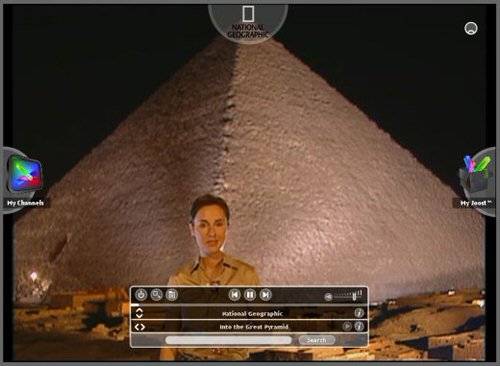
The video controls are fairly standard: play, pause, skip to next/last program, and
volume controls. You can also change channels, or skip ahead to a specific program (not
just the next or last), and get info about a program or channel — not unlike the
controls found on digital cable and satellite services. The video control bar also
includes a search box, that allows you to search by keyword for specific programs, or
programs on a certain subject (although this is fairly limited, with such a small program
catalog).
Joost’s channel browser is easy to use. You scroll through channels with up and down
arrows, and you can get a list of specific programs prior to committing – so you can
select a specific program to download.
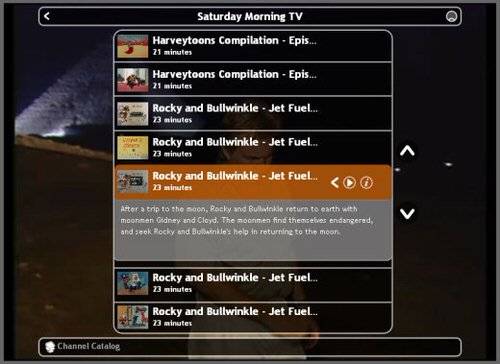
Joost also has a fairly extensive preferences screen, allowing you to fine tune the
user interface by changing things – like the delay before the toolbars reappear when you
hover your mouse near the edge of the screen, and whether or not you start in full-screen
mode.
Widgets
Widgets are something that only Joost has and really sets them apart from the other IPTV
providers. Widgets are extensions that add extra, non-television functionality to the
Joost program. Right now, Joost’s selection of widgets are: Notice Board (news about
Joost), Instant Message (chat with Jabber or Gmail users from within Joost), Rate (rate
programs), Channel Chat (chat with other users watching the program), News Ticker (an RSS
reader that you can use to track outside feeds), and Clock (uh, it tells the time). The
widgets are all very easy to use and work well.
Widgets are a very smart addition to Joost. They offer a social aspect to Joost that
other startups don’t have, allowing users to interact with the content and each other.
Further, they minimize the time you are forced to leave Joost in order to get things
done.
Babelgum
Joost may be the biggest
fish in the pond, but Babel Gum is
a very able-bodied competitor. Founded by Italian billionaire Silvio Scaglia (of FastWeb
fame), Babelgum is another on demand IPTV software program that looks and feels
remarkably like Joost. While they haven’t gotten nearly as much press as Joost, they have
offices in 4 countries, and they don’t seem worried about Joost. “When I started work on
this a year and a half ago I was afraid we’d end up with five [competing IPTV services],”
founder Scaglia told the Financial Times in
January. “The fact it’s still two probably gives us a good lead.” Babelgum is currently
operating in closed beta mode.
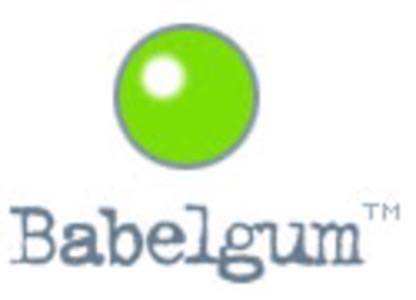
Content
Content on Babelgum right now is extremely limited. There are only 9 channels available
to users. These are mostly made up of amateur or independent content. Amongst others,
there is a News channel that shows news from the Associated Press, a Cartoons channel
(which has some pretty neat indie cartoon shorts), a Blogs channels that shows episodes
of Rocketboom, and a Trailer channel that shows movie trailers.

Babelgum is trying to entice content
owners with a pitch on their site. They call Babelgum “an ideal platform for content
owners to serve directly the Long Tail of viewers’ interests not addressed by
today’s broadcasting television networks.” They don’t charge anything to distribute
content and promise payment of US$5 for each 1000 unique views, of any clip put on their
network. This seems like it might be a good deal for amateur content producers, but it
likely won’t attract the mainstream media companies (which I’m not sure Babelgum is
really trying to do anyway).
Features/UI
Babelgum’s interface is very much like Joost’s. Video controls are on the left side, but
can be moved any way. The standard volume, play, pause, forward and back are there, but
unlike with Joost there is no way to scroll through channels and find the program you
want before switching. You also can’t rewind programs the way you can in Joost (perhaps
the content on Babelgum isn’t being cached?). Rather disappointingly, Babelgum only comes
in two sizes : full screen, and not full screen. While in not full screen mode,
you can’t resize the window.
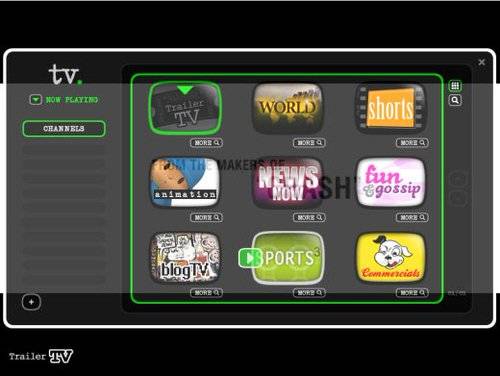
The channel browser in Babelgum is easy enough to use. You access it by pressing the
“TV” button along the bottom of the screen, or on the video control bar. The browser
lists channels in grid format by default, or in a scrollable one-per-page view. This is
easy enough when there are only 9 channels, but when there are more, I am not sure how
well this format will scale. You can, however, create custom lists of your favorite
channels — rather useless at the moment, but could be helpful if there are ever hundreds
of channels. In rather annoying fashion, clicking on a channel doesn’t do anything — you
have to click the green ‘play’ button to load up the channel, or click ‘more info’ to get
a listing of programs and description of the channel. Babelgum’s channel browser is more
visually pleasing than Joost’s, however, and the channel and program descriptions are far
more complete.
Babelgum doesn’t really offer any more features to speak of. There is a button on each
program page allowing you to save it to a “Video” section (sort of a favorites lists),
which is something like TiVo for IPTV. But since everything is on demand, this may have
limited usefulness. You can also rate programs from the channel browser.
Zattoo
Swiss startup Zattoo is taking a different tack towards
IPTV than either Joost or Babelgum. Currently only available to users in Switzerland,
Zattoo is a software product that streams actual broadcast and cable television networks,
rather than operating an on demand service. Though Zattoo is only available in
Switzerland, they are based in Ann Arbor, Michigan, USA.

Content is where Zattoo really excels, offering over 40 channels to its Swiss users.
They plan to expand into other countries as they sign content distribution deals with
media companies that allow them to do so. The channels they offer are mainstream
broadcast and cable stations – such as BBC World, CNN International, Canale 5, Viva, and
Italia 1. Many of the channels are in German, French, and Italian, making them rather
hard to understand for a unilingual American like myself (though I did enjoy watching
episodes of ‘The Nanny’ in German and ‘Step by Step’ in Italian), but the quality of the
programming on these channels is top notch.
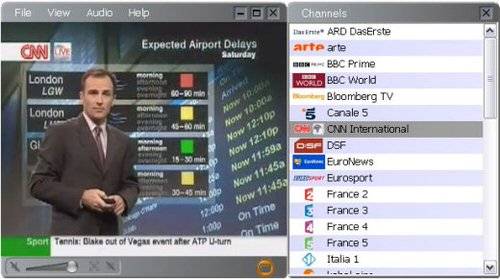
The interface of Zattoo is very simple and more traditional, looking a lot more like a
Windows or Mac program than the others. Because Zattoo is streaming actual TV stations,
there is no need for video controls. Zattoo’s interface is adorned with just volume and
screen size controls. The channel browser loads on the side of the application and is,
like the rest of the app, very simple and easy to use; it can be hidden with a
click.
Since Zattoo is showing real streaming TV, it would be a very welcome addition if they
added a channel guide showing what was on, and when.
ChooseAndWatch and Free Tube
ChooseAndWatch and FreeTube are nothing like the three programs previewed above, but
nonetheless they warrant a brief mention in the conversation. They are sites that
aggregate streaming video channels from around the web, from a mixture of mainstream TV
channels like ESPN, ABC, Al Jazeera, and the BBC; to more amateur, independent networks.
FreeTube claims to have 324 channels, while ChooseAndWatch boasts “more than 250.”
However, due to using ActiveX controls to launch the video applets, and a mish mash of
formats (i.e. some channels use QuickTime while others use Windows Media Player) the
sites both suffer from browser incompatibilities and channels that just plain don’t work.
From a content selection standpoint, however, if legal these sites beat Joost, Babelgum,
and Zattoo hands down. A word of caution: both websites offer adult content areas.

Conclusion
It’s too early to say who will come out on top in the IPTV battle. From a strictly
technological standpoint, Joost’s offering is the best out there right now. But Babelgum
offers a solid product as well, so it will ultimately come down to content.
Zattoo currently leads the game on content, but being only available in Switzerland
will obviously keep them from growing very fast. Also being a strictly live streaming
service (not on demand), Zattoo may not be compelling enough to divorce people from their
TVs.
The IPTV marketplace is heating up and these early startups have so far impressed.
That all three software startups profiled above are finalists for the
Red Herring 100 Europe 2007 award is proof enough of that.





















